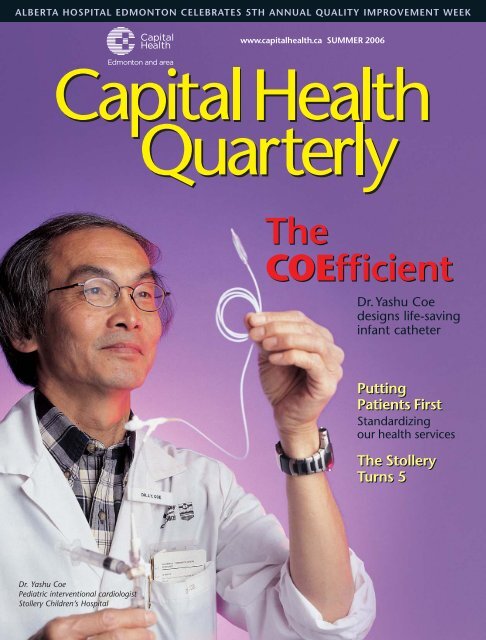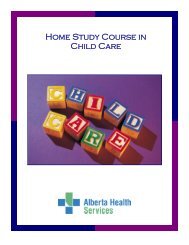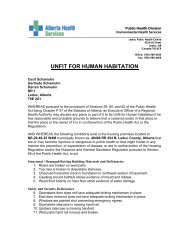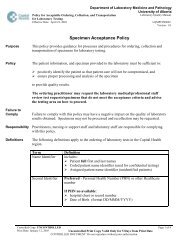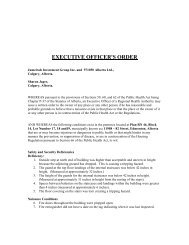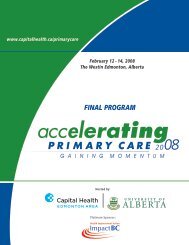The COEfficient The COEfficient - Capital Health
The COEfficient The COEfficient - Capital Health
The COEfficient The COEfficient - Capital Health
Create successful ePaper yourself
Turn your PDF publications into a flip-book with our unique Google optimized e-Paper software.
ALBERTA HOSPITAL EDMONTON CELEBRATES 5TH ANNUAL QUALITY IMPROVEMENT WEEK<br />
www.capitalhealth.ca SUMMER 2006<br />
<strong>The</strong><br />
<strong>COEfficient</strong><br />
Dr. Yashu Coe<br />
designs life-saving<br />
infant catheter<br />
Putting<br />
Patients First<br />
Standardizing<br />
our health services<br />
<strong>The</strong> Stollery<br />
Turns 5<br />
Dr. Yashu Coe<br />
Pediatric interventional cardiologist<br />
Stollery Children’s Hospital
It’s hard not to get excited about an innovation in heart<br />
care that’s this big. When the doors open to the<br />
Mazankowski Alberta Heart Institute in 2007, the lives<br />
of adults and children will be bettered and saved<br />
through skill, research and state-of-the-heart technology.<br />
Sincere thanks to the Government of Alberta for its<br />
contribution of $156 million and to the University<br />
Hospital Foundation fundraising cabinet led by Bill<br />
Comrie, JR Shaw and Dennis Erker for securing $40<br />
million in private donations. This Heart Institute is<br />
destined to be among the most advanced and respected<br />
clinical care, research and education facilities in the world<br />
today. Right here in Edmonton, we’ll care for patients<br />
from Alberta, the Prairies and the Canadian North.<br />
Naturally, our maximum heart rate is attained just<br />
thinking about this building with heart. days to go.<br />
www.capitalhealth.ca/albertaheartinstitute
SUMMER 2006<br />
IN FOCUS<br />
5 Putting Patients First<br />
<strong>Capital</strong> <strong>Health</strong> takes the next step to becoming<br />
a more integrated health system by streamlining<br />
the access and standardizing the delivery of health<br />
services across the region.<br />
COLLABORATING IN CARE<br />
10 New Institute a Living Laboratory<br />
11 Naming the Edmonton Clinic<br />
12 Weight Wise for the Long Haul<br />
IN THE COMMUNITY<br />
14 Elite Transport Team<br />
BEST PRACTICES<br />
16 Stollery Children’s Hospital Turns 5<br />
17 ABACUS Research Centre<br />
18 Quality Improvement Week at<br />
Alberta Hospital Edmonton<br />
20 <strong>Health</strong> Informatics<br />
NEWS AND NOTES<br />
21 Bob Normand Joins Board<br />
21 A Resource for Research<br />
22 WebLinks<br />
20<br />
FEATURES<br />
7 Miniaturizing Tools for Tots<br />
<strong>The</strong> <strong>COEfficient</strong>, as this tot-specific catheter is<br />
called, was named after Dr. Yashu Coe, a pediatric<br />
cardiologist at the Stollery Children’s Hospital. His<br />
design, accepted around the world, has now been<br />
approved by the U.S. Food and Drug Administration.<br />
8 Pandemic Planning for Business<br />
Dr. Sherry Cooper, Chief Economist at BMO Nesbitt<br />
Burns, talks about the importance of business<br />
continuity planning at a <strong>Capital</strong> <strong>Health</strong> breakfast.<br />
16 7 18<br />
ON THE COVER: Dr. Yashu Coe by Laughing Dog Photography<br />
THIS PAGE: Dr. Nicola Shaw (left) and Dr. Shoo Lee by Stephen Wreakes/<br />
<strong>Capital</strong> <strong>Health</strong> (top left), Stollery celebration by Pat Marston/<strong>Capital</strong> <strong>Health</strong><br />
(bottom left), catheters by Laughing Dog Photography (bottom middle),<br />
AHE Quality Improvement team members clockwise from top: Janice<br />
Godbout, Susan Hample, Christine North and Rosie Thornton by<br />
Robert Strand/<strong>Capital</strong> <strong>Health</strong> (bottom right).<br />
Canada Post Publications Mail<br />
Agreement Number 40639561<br />
www.capitalhealth.ca SUMMER 2006 ~ CHQ 3
FROM THE DESK OF SHEILA WEATHERILL<br />
Putting the Patient<br />
at the Centre of Care<br />
Historically, the health system in Alberta was structured around<br />
independently-operated hospitals and<br />
services. <strong>The</strong>re was no linkage among<br />
health services or co-ordination among<br />
physicians – patients had to figure out<br />
whom to call and where to go.<br />
In becoming a health region 11 years<br />
ago, we built an integrated care model<br />
within the health system, providing<br />
a complete range of health services<br />
in addition to emergency and acute<br />
care – from home care and continuing<br />
care, to public and community health,<br />
mental health and rehabilitation.<br />
With regionalization, we centralized<br />
our governance structure and administration,<br />
and consolidated our finance,<br />
human resources, IM/IT and communications<br />
departments. But there was<br />
little standardization or co-ordination<br />
of health services among sites and<br />
sectors. Patients were still being asked<br />
to register and re-register whenever<br />
and wherever they entered the system.<br />
Today, we take the next step in our<br />
goal to become a fully integrated<br />
health system with a major initiative<br />
to standardize health services across<br />
the <strong>Capital</strong> <strong>Health</strong> region. Just as we<br />
did by linking site information systems<br />
through netCARE so patients need only<br />
register once, we are streamlining the<br />
access and delivery of health services<br />
to provide patients with a co-ordinated<br />
continuum of services to support their<br />
care and guide them through the<br />
health system.<br />
We need to integrate services both<br />
within programs and among programs<br />
to ensure collaborative, co-ordinated<br />
and comprehensive service delivery.<br />
Turn to page 5 to read about our vision<br />
and the seven key service areas which<br />
make up the projects in <strong>Capital</strong> <strong>Health</strong>’s<br />
Regional Integration initiatives.<br />
On May 30, <strong>Capital</strong> <strong>Health</strong> completed<br />
Operation Outbreak 2, its second<br />
pandemic planning tabletop exercise,<br />
to test its emergency preparedness<br />
by guiding 200 leaders through a<br />
real-life scenario. <strong>The</strong> next day, BMO<br />
Chief Economist Dr. Sherry Cooper<br />
spoke at a <strong>Capital</strong> <strong>Health</strong> breakfast on<br />
the economic impact of a pandemic.<br />
You can read about both events in<br />
this issue.<br />
Congratulations to Dr. Gerry Predy,<br />
who received the Heart and Stroke<br />
Foundation of Canada’s Leadership<br />
Award August 11 for his contributions<br />
to heart health policy. Dr. Predy<br />
established the Urban Public <strong>Health</strong><br />
Network in 18 cities across the country<br />
to allow Canada-wide collaboration<br />
on healthy public policy initiatives.<br />
I would like to welcome Bob Normand,<br />
President and CEO of ATB Financial,<br />
to the <strong>Capital</strong> <strong>Health</strong> Board. One of<br />
the primary roles of the Board is to<br />
promote the provision of integrated<br />
heath services.<br />
By building a strong customer-focused<br />
organization we can provide people<br />
with more choice in accessing health<br />
services while improving the quality<br />
and safety of patient care and the<br />
performance of the health system.<br />
In planning for a more integrated<br />
and consistent approach to delivering<br />
health services across <strong>Capital</strong> <strong>Health</strong><br />
region, we will always embrace<br />
that which places the patient and<br />
the client at the centre of care.<br />
Quite simply, we are building a<br />
health system that puts patients<br />
and clients first.<br />
Sincerely,<br />
Sheila Weatherill, C.M.<br />
President and CEO<br />
www.capitalhealth.ca<br />
<strong>Capital</strong> <strong>Health</strong> Quarterly is published by <strong>Capital</strong> <strong>Health</strong> Public Affairs.<br />
EDITOR<br />
Dawna Freeman<br />
dawnafreeman@cha.ab.ca<br />
780-482-8660<br />
ART DIRECTOR<br />
Julie Wons<br />
CONTRIBUTING WRITERS<br />
Tannis Baradziej, Ronna Bremer, Steve Buick, Dawna Freeman,<br />
Melanie Friesacher, Karen Karbashewski, Juliet Kershaw, Jeanette<br />
LaBrie-Cable, Jo-anne Nugent, Barb Petryk, Rob Stevenson<br />
CONTRIBUTING ILLUSTRATORS/PHOTOGRAPHERS<br />
Karen Karbashewski, Jeanette LaBrie-Cable, Laughing Dog<br />
Photography, Pat Marston, Robert Strand, Stephen Wreakes<br />
We welcome your story ideas and comments. Send your<br />
comments to the Editor at dawnafreeman@cha.ab.ca.<br />
Photos and articles may not be reproduced without the<br />
written consent of the Editor.<br />
HOW TO REACH US<br />
<strong>Capital</strong> <strong>Health</strong> Public Affairs<br />
1J2.51 Walter C. Mackenzie Centre<br />
8440-112 Street<br />
Edmonton, AB T6G 2B7<br />
<strong>Capital</strong> <strong>Health</strong> Quarterly is printed by Nisku Printers (1980) Ltd.<br />
on 80 lb Chorus Art Silk (50% recycled stock).<br />
© Contents copyright 2006 by <strong>Capital</strong> <strong>Health</strong>.<br />
4 CHQ ~ SUMMER 2006 www.capitalhealth.ca
IN FOCUS<br />
<strong>The</strong>re is a whole world of difference between good care<br />
and good care that is properly co-ordinated.<br />
<strong>Capital</strong> <strong>Health</strong> shows the will and the way<br />
Pushing the envelope<br />
of regional integration<br />
If Michele Lahey’s forecast is correct,<br />
<strong>Capital</strong> <strong>Health</strong> is on its way to becoming<br />
the most integrated health region in<br />
Canada.<br />
But wait, you say, isn’t <strong>Capital</strong> <strong>Health</strong><br />
already the most integrated health<br />
region in the country?<br />
Since regionalization 11 years ago,<br />
<strong>Capital</strong> <strong>Health</strong> has become an<br />
exemplary model of integrated care,<br />
merging acute and emergency care<br />
with community and long term care,<br />
public health, mental health and<br />
rehabilitation.<br />
<strong>The</strong> development of Canada’s first<br />
region-wide electronic health record,<br />
netCARE, was another leading example<br />
of integration through the use of<br />
technology, linking patient records<br />
across all sites and sectors.<br />
“Integration has as many definitions<br />
as it has degrees,” says Michele,<br />
Executive Vice-President and Chief<br />
Operating Officer, <strong>Health</strong> Services.<br />
“It may be structural, or functional,<br />
or clinical. But like our quality improvement<br />
initiatives, it’s ongoing. We have<br />
become more integrated, and with<br />
the functional electronic health record<br />
(EHR) infrastructure firmly in place,<br />
we’re in a position to take clinical<br />
integration a step further.”<br />
Michele is leading <strong>Capital</strong> <strong>Health</strong>’s<br />
vision to improve the quality of care<br />
through a more integrated approach<br />
to delivering health services across the<br />
region. With the current pressures on<br />
health care resources, it is no longer<br />
practical to expect individual programs<br />
to provide comprehensive care for<br />
today’s complexity of patient needs.<br />
“Right now, there are areas in our<br />
system that are fragmented and<br />
cumbersome. We have dozens of<br />
vertical spikes,” she says, sketching the<br />
individual silos representing <strong>Capital</strong><br />
<strong>Health</strong>’s services and programs on<br />
her notepad as she talks. “A patient<br />
has to navigate a sea of services;<br />
we don’t always make it easy for<br />
them to move among services.”<br />
<strong>The</strong>n she strikes several horizontal<br />
lines through all silos.<br />
“We need to create horizontal<br />
structures across the whole continuum.<br />
We need to integrate services both<br />
within programs and among programs<br />
to ensure collaborative, co-ordinated<br />
and comprehensive service delivery.”<br />
Clinical Integration<br />
Full segregation Linkage Co-ordination Co-operation Full integration<br />
www.capitalhealth.ca SUMMER 2006 ~ CHQ 5
IN FOCUS<br />
An integrated health system is ‘a network of organizations that provides<br />
a co-ordinated continuum of services to a defined population.’<br />
Putting the patient<br />
at the centre<br />
As <strong>Capital</strong> <strong>Health</strong> moves deeper into<br />
regional integration, it will continue<br />
to build its health system around the<br />
patient in order to reduce complexity<br />
for patients and to provide staff with<br />
a more standardized approach to<br />
caregiving.<br />
Seven key service areas have been<br />
identified for Phase I integration<br />
projects: neurosciences, chronic<br />
disease management, bone and joint<br />
health, cancer services, emergency<br />
services, ambulatory care and mental<br />
health.<br />
Some projects, like stroke and<br />
arthoplasty, are already well underway,<br />
while others such as emergency<br />
services and system capacity were<br />
added in Phase I to address ER<br />
pressures sooner.<br />
Dr. Ken Gardener, Vice-President,<br />
Medical Affairs and medical lead for<br />
Regional Integration, outlined the six<br />
key elements that are fundamental<br />
to a fully integrated health care<br />
organization:<br />
• patient-centred approach<br />
• single and/or central point of access<br />
• standardized evidence-based<br />
approach across the care continuum<br />
• information systems to link<br />
providers<br />
• continuous improvement through<br />
monitoring and evaluation<br />
• improved use of resources<br />
Success, he says, will be measured by<br />
improvements in quality and safety,<br />
access, collaboration and productivity.<br />
“We need to reduce the complexity<br />
for patients so they are supported<br />
in a timely way,” said Dr. Gardener.<br />
“And we need to create an infrastructure<br />
to support staff so they have<br />
what they need to deliver the care.”<br />
Michele says projects will follow the<br />
same basic planning framework now<br />
used to create five-year service plans,<br />
and the process will be standardized<br />
for all integration projects. “We are<br />
looking at how we deliver care for<br />
each patient group, such as orthopedics,<br />
from their first contact with<br />
<strong>Capital</strong> <strong>Health</strong> all the way through<br />
the system.”<br />
Those involved in planning the more<br />
integrated approach to delivering<br />
health services represent every health<br />
provider of that particular patient<br />
group, she says. “Together they’re<br />
asking what is the best care, what<br />
are the best practices we know of,<br />
how can we change what we do<br />
and how can we evaluate to see<br />
if we’re making a difference.”<br />
Michele admits the regional approach<br />
to integrate health services through<br />
a seamless and co-ordinated delivery<br />
of care is huge in scope given the size<br />
and complexity of <strong>Capital</strong> <strong>Health</strong>.<br />
“But it’s not magical; it’s good management.<br />
We have 11 years experience as<br />
a regional system and the health care<br />
environment is constantly evolving.<br />
To continue as we are would be to<br />
lose ground. Now we need to become<br />
a fully integrated health care organization.<br />
We are pushing the envelope,<br />
but that’s the culture of <strong>Capital</strong><br />
<strong>Health</strong>.”<br />
“We need to integrate services<br />
both within programs and<br />
among programs to ensure<br />
collaborative, co-ordinated and<br />
comprehensive service delivery.”<br />
MICHELE LAHEY<br />
EXECUTIVE VICE-PRESIDENT<br />
AND CHIEF OPERATING OFFICER,<br />
HEALTH SERVICES<br />
“We need to reduce the<br />
complexity for patients<br />
so they are supported in<br />
a timely way.”<br />
DR. KEN GARDENER<br />
VICE-PRESIDENT, MEDICAL AFFAIRS<br />
AND MEDICAL LEAD, REGIONAL<br />
INTEGRATION<br />
6 CHQ ~ SUMMER 2006 www.capitalhealth.ca
FEATURE<br />
Miniaturizing tools for tots<br />
Physician-designed<br />
infant catheter<br />
finds open market<br />
Dr.Yashu Coe,<br />
pediatric interventional cardiologist at the Stollery Children’s<br />
Hospital, says the mortality rate for the treatment of defective<br />
heart valves in infants is now zero per cent. “Here at the Stollery,<br />
we’ve never had a procedural or late mortality.”<br />
Each year, the Stollery Children’s<br />
Hospital treats five to 10 infants for<br />
aortic stenosis (a narrowed aortic valve),<br />
one of eight common abnormalities that<br />
account for approximately 80 per cent<br />
of congenital heart defects.<br />
At one time, surgery was the treatment<br />
of choice. <strong>The</strong>n, 10 to 20 years ago,<br />
angioplasty offered an alternative.<br />
This procedure involves inserting<br />
and guiding a catheter into the heart<br />
through either a vein or an artery and<br />
inflating a balloon across the valve to<br />
eliminate the severely narrow valve<br />
opening. When he first began using<br />
Adult catheter (left) guide wire is<br />
0.035 inches compared with the infant<br />
catheter (right) at 0.018 of an inch.<br />
<strong>The</strong> infant catheter is more flexible<br />
and slimmer, allowing for easier<br />
navigation through the heart.<br />
this procedure, Dr. Coe found the<br />
balloon too fragile or the catheter<br />
too big for tiny babies’ bodies, and<br />
was determined to find a solution<br />
to improve the treatment for these<br />
critically sick infants.<br />
After conducting initial research,<br />
Dr. Coe, also a Professor of Pediatrics at<br />
the University of Alberta, approached<br />
various manufacturers to help him<br />
custom design a catheter to his specifications.<br />
When he finally discovered<br />
NuMed, a U.S. manufacturer with<br />
a facility in Canada, within a month,<br />
Dr. Coe had in hand his tot-specific<br />
catheter for angioplasty operations.<br />
“What’s neat about this is that it’s small;<br />
and the balloon – it’s very, very strong.”<br />
<strong>The</strong> <strong>COEfficient</strong>, as the tool is named,<br />
has since saved the lives of many infants.<br />
<strong>The</strong> catheter is now also used to<br />
correct severely malfunctioning<br />
pulmonary valves in newborns,<br />
at times a life-threatening condition<br />
that must be addressed immediately.<br />
Angioplasty operations come with the<br />
additional blessing that “the baby can<br />
usually go home sooner,” says Dr. Coe,<br />
unlike the longer recovery period<br />
required for more invasive surgery.<br />
With its new U.S. Food and Drug<br />
Administration’s stamp of approval,<br />
the <strong>COEfficient</strong> is ready for the open<br />
market. Until recently it was little known.<br />
In fact, not long ago in Germany,<br />
a delighted Dr. Coe impressed staff<br />
at a hospital he was visiting when<br />
they proudly revealed their “new”<br />
infant catheter – then discovered<br />
the design was his.<br />
LAUGHING DOG PHOTOGRAPHY<br />
www.capitalhealth.ca SUMMER 2006 ~ CHQ 7
FEATURE<br />
Real-life Exercise Tests <strong>Capital</strong> <strong>Health</strong>’s Emerge<br />
You plan.<br />
You prepare.<br />
You react.<br />
A good plan helps your<br />
best efforts succeed.<br />
<strong>Capital</strong> <strong>Health</strong> put<br />
its emergency plan<br />
to the test by guiding<br />
its leaders through<br />
a real-life scenario.<br />
It was Operation Outbreak 2 –<br />
the scenario: suspect cases of<br />
severe respiratory illnesses surfacing<br />
in Southeast Asia and Asia. Weeks<br />
later, three suspect cases show up<br />
at the Northeast Community <strong>Health</strong><br />
Centre in Edmonton. Alberta <strong>Health</strong><br />
and Wellness is notified. <strong>Capital</strong><br />
<strong>Health</strong>’s Regional Emergency Co-ordination<br />
Centre (RECC) is activated.<br />
<strong>The</strong> pandemic planning tabletop<br />
exercise included about 200 people<br />
from <strong>Capital</strong> <strong>Health</strong>, Caritas <strong>Health</strong><br />
Group and the Alberta Cancer Board.<br />
It involved the activation of the<br />
Policy Group, the RECC and the Site<br />
Emergency Operations Centres at the<br />
University of Alberta Hospital, Stollery<br />
Children’s Hospital, Royal Alexandra<br />
Hospital, Misericordia Hospital and<br />
the Sturgeon Hospital.<br />
<strong>The</strong> scenario was introduced to<br />
the entire group. It created a buzz<br />
in the room as site and planning<br />
teams worked diligently through<br />
the exercise, responding to different<br />
circumstances as the situation became<br />
more serious. <strong>The</strong> response needed<br />
to be co-ordinated and focused on<br />
protecting the health of patients,<br />
staff, and the public.<br />
This was the second phase of Operation<br />
Outbreak. <strong>The</strong> first exercise took place<br />
in June 2005. Its success initiated<br />
planning for further, more interactive<br />
emergency response activities.<br />
“<strong>The</strong> public expects their health care<br />
needs to be met regardless of what<br />
incident has taken place. We need to<br />
be able to respond to the emergency<br />
situation and limit its effects on<br />
<strong>Capital</strong> <strong>Health</strong>’s daily operations –<br />
to deliver the standard of care people<br />
expect from our health service<br />
providers,” said Dr. Gerry Predy,<br />
<strong>Capital</strong> <strong>Health</strong>’s Vice-President of<br />
Public <strong>Health</strong> and Medical Officer<br />
of <strong>Health</strong>.<br />
“With a potential flu pandemic,<br />
employees may be sick or be home<br />
caring for family members. We need<br />
to test our emergency and business<br />
continuity plans so the public is<br />
comfortable knowing it can continue<br />
to rely on <strong>Capital</strong> <strong>Health</strong> to deliver<br />
health services.”<br />
Communication is a key component<br />
in any emergency situation. For the<br />
first time, telehealth equipment was<br />
tested as part of the tabletop exercise.<br />
It linked emergency operation centres<br />
at several different sites. <strong>The</strong> technology<br />
is a valuable tool to strengthen<br />
communication lines with <strong>Capital</strong><br />
<strong>Health</strong> sites and the RECC.<br />
“<strong>The</strong> tabletop exercise is testing<br />
the plan, not the people. If the plan<br />
8 CHQ ~ SUMMER 2006 www.capitalhealth.ca
ncy Plan<br />
DR. SHERRY COOPER<br />
Pandemic Planning – An Economist’s View<br />
JEANETTE LABRIE-CABLE/CAPITAL HEALTH (PANDEMIC EXERCISE SERIES)<br />
<strong>Capital</strong> <strong>Health</strong>’s second pandemic<br />
planning tabletop exercise this spring<br />
involved 200 people from <strong>Capital</strong> <strong>Health</strong>,<br />
Caritas and Alberta Cancer Board.<br />
is well-designed, it will allow our staff<br />
to succeed in their designated roles.<br />
No plan is perfect. We need to figure<br />
out where those gaps are and what<br />
lessons can be learned,” said Eric Bone,<br />
<strong>Capital</strong> <strong>Health</strong>’s Regional Director,<br />
Office of Emergency Preparedness.<br />
“<strong>The</strong> best written plan is one that can<br />
be changed at a moment’s notice.”<br />
<strong>The</strong> value of Operation Outbreak<br />
was in the dialogue that took place<br />
during the exercise. Communication<br />
strategies were essential for the team<br />
to work together to relay key planning<br />
messages to staff.<br />
“Exercising a plan allows <strong>Capital</strong><br />
<strong>Health</strong> staff to understand the process.<br />
It will identify planning weaknesses<br />
and resource gaps, clarify roles and<br />
responsibilities, improve co-ordination,<br />
test equipment and reassure the public<br />
that <strong>Capital</strong> <strong>Health</strong> is prepared,” said<br />
Eric.<br />
At the end of the day – lessons were<br />
learned. <strong>The</strong> emergency preparedness<br />
plan will be further fine-tuned, taking<br />
<strong>Capital</strong> <strong>Health</strong> another step closer to<br />
effectively handling pandemic influenza<br />
or any other emergency situation.<br />
<strong>The</strong> human and social costs of a possible pandemic are unimaginable.<br />
But experts predict an outbreak could also have devastating effects on our<br />
economy – potentially costing more than $3 trillion worldwide. Businesses<br />
of all sizes need to manage the risk. Effective plans can help minimize the<br />
damage to the economy and individual operations.<br />
Dr. Sherry Cooper, Chief Economist at BMO Nesbitt Burns, shared her expertise<br />
on the importance of business continuity planning with dozens of businesses<br />
at a <strong>Capital</strong> <strong>Health</strong> breakfast in May. Dr. Cooper estimates a flu pandemic<br />
will cost the Canadian economy anywhere from $20 to $60 billion, depending<br />
on the severity of the outbreak. She predicts the industries most affected will<br />
be poultry, tourism, hospitality, entertainment, sports facilities, food services<br />
and luxury goods suppliers.<br />
Preparing now is critical to limiting the effects of a pandemic. Companies<br />
should be ready to deal with absenteeism, changes in the delivery of public<br />
services, and a slowdown in the global economy.<br />
“Governments, businesses, health services and individuals must continue to<br />
develop continuity and emergency preparedness plans and test and retest these<br />
plans as well as revise them as the situation changes,” says Dr. Cooper.<br />
Business should expect a 30 per cent reduction in the workforce. Cross-training<br />
is essential to have employees prepared to step into critical roles and companies<br />
should plan to have staff work from home if necessary.<br />
Pandemic is unlike other natural disasters, it can be prolonged, with no fixed<br />
location and no set end date.<br />
Dr. Cooper says it’s important to remember that even with a severe pandemic,<br />
roughly 98 per cent of the world’s population will survive. Borders will reopen<br />
and the flow of goods and services will start again. <strong>The</strong> global economy will move<br />
forward and businesses and government will have learned valuable lessons.<br />
For more information on pandemic planning check <strong>Capital</strong> <strong>Health</strong> website at:<br />
http://www.capitalhealth.ca/pandemicbusinesschecklist<br />
www.capitalhealth.ca SUMMER 2006 ~ CHQ 9<br />
STEPHEN WREAKES/CAPITAL HEALTH
COLLABORATING IN CARE<br />
New ‘living laboratory’ puts women and children first<br />
Wendy Beaudoin with three-year-old<br />
daughter Olivia and Dr. Thierry Lacaze,<br />
neonatologist and Acting Director of the<br />
Women and Children’s <strong>Health</strong> Research<br />
Institute.<br />
THE UNIVERSITY OF ALBERTA AND<br />
<strong>Capital</strong> <strong>Health</strong> have announced<br />
a joint commitment to create the<br />
region’s first-ever research institute<br />
dedicated to women and children’s<br />
health. Thanks to commitments of<br />
$37 million from our communities<br />
through the Stollery Children’s Hospital<br />
($30 million) and Royal Alexandra<br />
Hospital ($7 million) Foundations,<br />
the new institute will be a potent<br />
force in the national research agenda<br />
in two critical fields.<br />
Clinicians will work with scientists<br />
across six University of Alberta faculties<br />
in the Women and Children’s <strong>Health</strong><br />
Research Institute to study and treat<br />
the full range of women and children’s<br />
health issues, from diagnosing and<br />
treating illness in utero and developing<br />
new treatments for autism, epilepsy<br />
and other child health problems,<br />
to new services for mature women.<br />
<strong>The</strong> institute will consist of three<br />
linked research centres:<br />
1. A children’s clinical research<br />
centre, to be located in the future<br />
Edmonton Clinic across 114 Street<br />
from the Walter C. Mackenzie Centre<br />
2. A women’s clinical research centre,<br />
to be part of the future Lois Hole<br />
Hospital for Women within the<br />
Robbins Pavilion, being built on<br />
the Royal Alexandra Hospital site<br />
3. A basic research centre, to be<br />
located within the future Discovery<br />
Centre being built on 87 Avenue<br />
just north of the University of<br />
Alberta Hospital site<br />
10 CHQ ~ SUMMER 2006 www.capitalhealth.ca<br />
“<strong>The</strong>se three centres will be the ‘life’<br />
in the ‘living laboratory’ that we’re<br />
envisioning for these new facilities,”<br />
says Dr. Terry Klassen, <strong>Capital</strong> <strong>Health</strong>’s<br />
Regional Clinical Program Director for<br />
Child <strong>Health</strong> and University of Alberta<br />
Chair of Pediatrics. “This is the leading<br />
edge of health sciences, where we<br />
study, develop, apply and evaluate<br />
new treatments as we care for patients<br />
in real time. It’s an exciting model and<br />
nowhere else in Canada is it possible<br />
on the scale we’re building here.”<br />
“This is a great day for patients and<br />
all the different health professionals<br />
who care for them,” adds Dr. Wylam<br />
Faught, Site Chief for Women’s <strong>Health</strong><br />
at the Royal Alexandra Hospital and<br />
Chair of Obstetrics and Gynecology<br />
for the University, at the May 24 news<br />
conference. “Women will have access<br />
to state-of-the-art care, and the work<br />
done here will benefit people right<br />
across Canada. <strong>The</strong> institute will<br />
not only build on many established<br />
strengths in the region but also help<br />
create new areas of expertise, like a<br />
mature women’s clinic at the Royal<br />
Alexandra.”<br />
Planning for the institute is being<br />
led by Dr. Thierry Lacaze, inaugural<br />
Acting Director. Dr. Lacaze is a neonatologist<br />
at the Stollery Children’s<br />
Hospital and Research Director in<br />
the University of Alberta Department<br />
of Pediatrics. He was recruited to<br />
Edmonton in 2003 from the University<br />
of Paris.<br />
<strong>The</strong> institute will include four new<br />
endowed research Chairs – starting<br />
with Dr. Lonnie Zwaigenbaum,<br />
who is joining the Stollery team this<br />
summer from McMaster University.<br />
Dr. Zwaigenbaum is known internationally<br />
as the author of a 2005<br />
study that pinpointed signs of incipient<br />
autism in infants as young as 12 months,<br />
paving the way for earlier and more<br />
effective intervention.<br />
<strong>The</strong> institute will be devoted to<br />
making life better for patients like<br />
three-year-old Olivia Beaudoin, who<br />
dropped in to the news conference<br />
along with mom Wendy, a nurse<br />
at the Stollery. Wendy told reporters<br />
she’s grateful for Olivia’s care – which<br />
started with a premature birth and<br />
eventually included five neurosurgeries.<br />
“Nobody should have to live their<br />
first year in the hospital, and so I think<br />
this is a huge step as far as research<br />
money to develop different techniques<br />
and different equipment. As a community,<br />
we need to strive for no surgeries<br />
for children, and this is a huge step in<br />
that direction.”<br />
<strong>Capital</strong> <strong>Health</strong> President and CEO,<br />
Sheila Weatherill, says Alberta is in<br />
the midst of a “baby boom” as young<br />
families move here for jobs, so the<br />
institute couldn’t be coming at a<br />
better time. “Our region’s population<br />
has grown eight per cent in the last<br />
five years; but births in our hospitals<br />
are up by 15 per cent, partly due to<br />
steadily growing numbers of moms<br />
and babies referred from northern<br />
Alberta, the Northwest Territories<br />
and elsewhere.” In total, she says, the<br />
region expects about 15,000 babies<br />
to be born here this year.<br />
PAT MARSTON/CAPITAL HEALTH
Community<br />
Pride Inspires<br />
the Name<br />
STEPHEN WREAKES/CAPITAL HEALTH<br />
the<br />
Mayo Clinic and the Cleveland<br />
Clinic draw patients from around<br />
the world, and in five years time, so<br />
will the Edmonton Clinic. In 2011,<br />
<strong>Capital</strong> <strong>Health</strong> and the University of<br />
Alberta will officially open the model<br />
for future academic health centres<br />
in North America and highlight<br />
Edmonton’s place on the health<br />
care map.<br />
Formerly called the <strong>Health</strong> Sciences<br />
Ambulatory Learning Centre, the<br />
new name is the strategic outcome<br />
brainstormed by University of Alberta<br />
President, Indira Samarasekera, and<br />
<strong>Capital</strong> <strong>Health</strong> President and CEO,<br />
Sheila Weatherill, who says, “<strong>The</strong><br />
name Edmonton Clinic reflects the<br />
pride we have in our community.”<br />
<strong>The</strong> $577-million clinic will concentrate<br />
health services, such as day clinics<br />
and diagnostic services from the<br />
University of Alberta Hospital and<br />
Stollery Children’s Hospital, into a<br />
“one-stop” family-centred complex.<br />
<strong>The</strong> result will free up space on existing<br />
wards and about 200 inpatient hospital<br />
beds.<br />
In addition to health services, the clinic<br />
will create interdisciplinary educational<br />
environment for 6,000 students from<br />
the university’s health sciences faculties.<br />
It is an innovative solution to the<br />
needs of a maturing capital region.<br />
Sheila elaborates, “This plan will help<br />
to ensure that we have the beds and<br />
trained health service providers to<br />
meet the current and future health<br />
needs of our growing and aging<br />
population.”<br />
<strong>The</strong> Edmonton Clinic will serve approximately<br />
one million patients annually.<br />
Deb Gordon, Vice-President and Chief<br />
Operating Officer of the University of<br />
Alberta Hospital and Stollery Children’s<br />
Hospital, says, “<strong>The</strong> Edmonton Clinic<br />
will integrate first-rate facilities,<br />
the electronic health record, and<br />
sophisticated scheduling systems so<br />
rural patients receive expert testing,<br />
advice and treatment quickly.”<br />
Decreased waiting times will see more<br />
patients being treated, and patients<br />
with complicated conditions won’t<br />
have to travel as much.<br />
<strong>The</strong> 168,000 square-metre clinic<br />
is in the design stage, which will take<br />
about a year. “Detailed planning is<br />
complete and now <strong>Capital</strong> <strong>Health</strong> and<br />
the University of Alberta are assembling<br />
teams of designers and builders,”<br />
says Brent Skinner, Chief Planning<br />
Officer for <strong>Capital</strong> <strong>Health</strong>. “Because<br />
the centre has a separate design<br />
team for both clinic and academic<br />
components, we’ve appointed a<br />
master architect, Mark Henderson<br />
of Callison Architecture, to ensure<br />
the design teams are working towards<br />
a common vision.”<br />
Construction of the Edmonton Clinic<br />
will be tendered in phases with the<br />
first stage beginning in spring 2007.<br />
<strong>The</strong> clinic will be located on the<br />
west side of 114 Street, next to<br />
the LRT station and connected to<br />
the University of Alberta Hospital<br />
by a pedway.<br />
www.capitalhealth.ca SUMMER 2006 ~ CHQ 11
COLLABORATING IN CARE<br />
Get Weight Wise f<br />
TOP: Johanna Dietrich, <strong>Capital</strong> <strong>Health</strong><br />
Website Content Manager; Dr. Richard<br />
Lewanczuk, Regional Medical Director,<br />
Chronic Disease Management and Professor<br />
of Endocrinolgy and Metabolism at the<br />
University of Alberta; and John Stanton,<br />
Community Ambassador for Weight Wise<br />
MIDDLE: Tracy Friesen, Integration Pilates<br />
BOTTOM: Gizmo Williams, Ex-Eskimos<br />
football player<br />
TOP: Anastasia Rozhdestvensky, Dance<br />
Alberta<br />
BOTTOM: Marg Zapf, executive associate<br />
for Joanna Pawlyshyn, executive lead<br />
for Weight Wise, and Vice-President<br />
and Chief Operating Officer of<br />
Royal Alexandra Hospital<br />
TOP: Dr. Geoff Ball, Director of <strong>Capital</strong><br />
<strong>Health</strong> Pediatric Centre for Weight and<br />
<strong>Health</strong> and Assistant Professor at the<br />
Department of Pediatrics at the university<br />
MIDDLE: Leah Gravells, Manager of<br />
Nutritional Services, <strong>Capital</strong> <strong>Health</strong><br />
BOTTOM: Velerie Chowaniec, Edmonton<br />
Yoga Studio<br />
12 CHQ ~ SUMMER 2006 www.capitalhealth.ca
or the long haul<br />
KAREN KARBASHEWSKI/CAPITAL HEALTH<br />
New effort promotes participation,<br />
lifestyle changes<br />
<strong>Capital</strong> <strong>Health</strong> is putting residents in the region in the<br />
driver’s seat with their new Weight Wise In It for the Long<br />
Haul initiative, a drive that is geared at helping residents<br />
eat healthier and increase their activity level while reducing<br />
their Body Mass Index and waist circumference.<br />
“We know that change will not occur<br />
overnight and that’s why we are in<br />
this for the long haul,” says Joanna<br />
Pawlyshyn, executive lead for <strong>Capital</strong><br />
<strong>Health</strong>’s Weight Wise initiative and<br />
Vice-President and Chief Operating<br />
Officer of Royal Alexandra Hospital.<br />
“We want to help residents in this<br />
region become healthier by providing<br />
them with information, tools and<br />
the incentive to help them become<br />
the most weight wise population<br />
in the country.”<br />
Weight Wise In It for the Long Haul<br />
is part of the larger Weight Wise initiative<br />
that <strong>Capital</strong> <strong>Health</strong> introduced<br />
last year. This comprehensive approach<br />
to addressing the obesity epidemic<br />
that exists in our population includes<br />
a number of programs and services<br />
ranging from promoting healthy<br />
lives to offering bariatric surgery for<br />
extremely obese adults. All of these<br />
efforts are designed to help adults<br />
and children reach healthy weights<br />
while supporting them to make lifestyle<br />
changes for improved health.<br />
Essentially it’s about creating healthy<br />
weights for healthy lives.<br />
Part of the Weight Wise In It for the<br />
Long Haul effort includes putting the<br />
tools and information into the hands<br />
of the public so that they can make<br />
wise and healthy decisions about<br />
the food that they eat, their activity<br />
levels, and other lifestyle factors.<br />
Using the interactive Weight Wise<br />
website residents can register<br />
to receive monthly newsletters,<br />
weekly reminders about inputting<br />
their progress on eating healthy<br />
and increasing their activity levels,<br />
as well as tracking their weight loss<br />
and waist circumference. All this<br />
is available just by signing up at<br />
www.capitalhealth.ca/weightwise.<br />
<strong>Capital</strong> <strong>Health</strong> will also work with<br />
its partners and others in the communities<br />
so that they can join in on the<br />
journey and help residents reach our<br />
objective – healthy weights for healthy<br />
lives for both children and adults.<br />
“We know that obesity is not something<br />
that the health system can<br />
tackle alone. It requires each one<br />
of us as individuals and as family<br />
members and community members<br />
to make wise choices about diet,<br />
exercise, and creating supportive<br />
environments to help people make<br />
good decisions,” says John Stanton,<br />
Community Ambassador for Weight<br />
Wise.<br />
“Becoming more weight wise is about<br />
making long-term commitments and<br />
lifestyle changes and that’s what we are<br />
looking to achieve with this exciting<br />
new effort. I encourage residents<br />
to sign up and join us as we work<br />
together to improve the health of<br />
our region.”<br />
Members of <strong>Capital</strong> <strong>Health</strong>’s<br />
Weight Wise Community Network<br />
support the prevention and<br />
management of weight and<br />
obesity issues and help individuals<br />
to improve healthy living habits.<br />
To find out how you can become<br />
a Network Member visit:<br />
www.capitalhealth.ca/weightwise<br />
CHIP – Coronary <strong>Health</strong><br />
Improvement Program<br />
Centre for Cognitive<br />
Behavioral <strong>The</strong>rapy<br />
Changes for Women<br />
City of Edmonton –<br />
Leisure, Sports and<br />
Fitness Facilities<br />
Club Fit Corporation<br />
Fit N Well Personal<br />
Training Inc.<br />
Kwantum Wellness Centre<br />
MacEwan Centre for<br />
Sport and Wellness<br />
Maximum Motion Personal<br />
Fitness Training, Inc.<br />
Rejuvenation <strong>Health</strong><br />
Services, Inc.<br />
Running Room Canada, Inc.<br />
Strathcona County,<br />
Recreation, Parks and Culture<br />
University of Alberta<br />
Fitness and Lifestyle Centre<br />
Weight Watchers of<br />
Alberta, Ltd.<br />
YMCA Edmonton<br />
www.capitalhealth.ca SUMMER 2006 ~ CHQ 13
IN THE COMMUNITY<br />
Stollery’s PICU celebrates 10 Years<br />
<strong>The</strong> sky’s the<br />
limit for this Elite<br />
Transport Team<br />
RN Joanna Byers sits beside the transport sled in the plane with<br />
flight paramedic David Hole behind the monitor.<br />
ozens of pairs of<br />
winter boots are<br />
lined up and ready<br />
to be laced for a<br />
mad dash, even in<br />
the heat of Alberta’s<br />
dry summer.<br />
<strong>The</strong>y belong to an elite<br />
group of specially trained<br />
physicians, nurses and respiratory<br />
therapists who make up the Stollery<br />
Children’s Hospital’s Pediatric Intensive<br />
Care Unit (PICU) transport team.<br />
This team provides specialized care<br />
of severely ill children during hospitalto-hospital<br />
transfers and transports by<br />
ambulance, helicopter and airplane.<br />
<strong>The</strong> team can be mobilized for a trip<br />
as far as the Arctic in just 20 minutes.<br />
This month, the PICU transport team<br />
celebrates its 10th anniversary.<br />
“In 1996, the first formally trained<br />
PICU transport team in Alberta was<br />
launched,” says the group’s Medical<br />
Director Dr. Allan de Caen. “We found<br />
that there were children in hospitals<br />
within Edmonton and surrounding<br />
rural communities who were critically<br />
ill and needed not only definitive care<br />
from Pediatrics within Edmonton, but<br />
needed to be transported to us without<br />
deteriorating en route. For this<br />
reason, a specialized PICU transport<br />
team was developed.”<br />
A decade later, the team is now considered<br />
one of the busiest in Canada<br />
and serves the largest geographic area,<br />
stretching from parts of eastern B.C.<br />
and the Yukon, across the central<br />
Arctic, and extending down into<br />
eastern Saskatchewan and southern<br />
Alberta as necessary. <strong>The</strong> team can<br />
bring the resources of the Stollery<br />
Children’s Hospital’s Pediatric Intensive<br />
Care Unit to the patient’s bedside.<br />
“We’ve learned to improvise in some<br />
very unusual situations,” says the<br />
team’s Unit Manager, Vanessa French.<br />
“We’ve coped with IV lines freezing in<br />
the Arctic, monitors that stop working<br />
in bitter cold conditions, and been<br />
COURTESY PICU TRANSPORT TEAM (PLANE)<br />
14 CHQ ~ SUMMER 2006 www.capitalhealth.ca
Stollery Children’s Hospital’s<br />
Pediatric Intensive Care Unit<br />
transport team:<br />
Back row, left to right:<br />
Eileen Heidler (RT), Shevaun<br />
Clark (RT), Darrell Derkach (RT),<br />
Shannon Duncan (RN), Kelly<br />
Stabler (RT), Colleen Gresiuk<br />
(RN), Dr. Jon Duff, Lindsay<br />
Lonsdale (RT), Christine Bichai<br />
(RT), Dr. Allan de Caen, Dave<br />
Schoepp (RT), Karen Tomlinson<br />
(RN), Esther Weathers (RT),<br />
Vanessa French (unit Manager).<br />
Front row, left to right:<br />
Joy Mekechuk (RN), Misty Reis<br />
(RN), Debra Anderson (RN),<br />
Tonia Polak (RN) Klara Vigen<br />
(RN), Cindi Ryan (RT).<br />
PAT MARSTON/CAPITAL HEALTH (GROUP)<br />
faced with a dispatch to pick up one<br />
critically ill child and on arrival learning<br />
we needed to transport three.”<br />
In the past 10 years, 2,500 sick children<br />
from the <strong>Capital</strong> <strong>Health</strong> region and<br />
beyond have been helped by this<br />
group. One of the most memorable<br />
and challenging transports occurred<br />
last summer when the team was asked<br />
to transport a cardiac patient from<br />
Winnipeg to the Stollery Children’s<br />
Hospital.<br />
Respiratory therapist, Kelly Stabbler,<br />
was part of the mission along with<br />
the Stollery Children’s Hospital’s Extracorporeal<br />
Life Support Team. “<strong>The</strong>re<br />
was so much equipment involved that<br />
we had to use a military Hercules<br />
aircraft for the transport. It took an<br />
amazing amount of co-ordination<br />
<strong>The</strong> team can be mobilized for a trip<br />
as far as the Arctic in just 20 minutes.<br />
with the medical team in Winnipeg,<br />
the emergency medical services<br />
personnel, even Winnipeg’s fire<br />
department.”<br />
<strong>The</strong> sky remains the limit for this<br />
team as it welcomes another decade<br />
of providing critical care for children.<br />
“We want to see an increase in our<br />
role in outreach education,” according<br />
to Dr. de Caen. “It takes time to<br />
reach most of our referral centres,<br />
and whatever we can do to better<br />
prepare the health care team in those<br />
centres to care for critically ill children<br />
before we arrive will ultimately<br />
make a difference in the outcome<br />
of children.”<br />
www.capitalhealth.ca SUMMER 2006 ~ CHQ 15
IN THE COMMUNITY<br />
<strong>The</strong> Stollery Children’s Hospital Turns 5<br />
LEFT: Six-year-old Lauryn Stubbs is with<br />
sisters Eden and Morganne, Dad Martin<br />
and Mom Jacqueline.<br />
BELOW, TOP: Lauryn presents her framed<br />
birthday card to Premier Ralph Klein,<br />
while Mom and <strong>Capital</strong> <strong>Health</strong> Board<br />
Chair Neil Wilkinson look on.<br />
BELOW, MIDDLE: Dr. Klassen, Premier Klein<br />
and Michele Lahey, Executive Vice-President<br />
and Chief Operating Officer, <strong>Health</strong> Services,<br />
watch the children blow out the candles.<br />
BELOW, BOTTOM: Premier Klein signs<br />
the keepsake banner.<br />
Premier Ralph Klein joins patients, physicians,<br />
staff and guests at the Stollery’s fifth birthday<br />
party on August 3.<br />
“It’s been great to see the Stollery grow into<br />
a centre of excellence, not just for Albertans<br />
but for all Canadians,” said the Premier,<br />
who received a special birthday card from<br />
six-year-old oncology patient Lauryn Stubbs.<br />
Several former Stollery patients were on hand<br />
to sing Happy Birthday and blow out the candles<br />
on the teddy bear cake.<br />
“Partnerships among <strong>Capital</strong> <strong>Health</strong>, the University of Alberta<br />
and our community as a whole have allowed us to become<br />
one of the top pediatric facilities in North America in just<br />
five years,” said Dr. Terry Klassen, Regional Clinical Program<br />
Director, Child <strong>Health</strong>, and Chair, Pediatrics, Faculty of<br />
Medicine and Dentistry, University of Alberta.<br />
<strong>The</strong> Stollery was granted official hospital status in 2001<br />
and this year will receive 140,000 patients visits.<br />
PAT MARSTON/CAPITAL HEALTH<br />
16 CHQ ~ SUMMER 2006 www.capitalhealth.ca
BEST PRACTICES<br />
ABACUS Brings Diversity of Professionals<br />
and Technologies Under One Roof<br />
Artistic rendering of ABACUS<br />
<strong>The</strong> Alberta Cardiovascular<br />
and Stroke Research Centre<br />
(ABACUS) is a new “research<br />
hospital within a hospital.”<br />
Located in the lower level<br />
of the Mazankowski Alberta<br />
Heart Institute, it’s the only<br />
Canadian research centre of<br />
its kind physically integrated<br />
into an acute care setting.<br />
It will assemble scientists, health care<br />
professionals, clinicians and trainees<br />
under one roof to focus on research<br />
into the prevention, detection and cure<br />
for cardiovascular disease and stroke.<br />
Heart disease, stroke, and blood vessel<br />
or vascular disease make up cardiovascular<br />
disease – the leading cause of<br />
death in Canadian women and men.<br />
“<strong>The</strong> facility is what the Canada<br />
Institutes of <strong>Health</strong> Research envisions<br />
as the optimum way of doing research,”<br />
says Dr. Stephen Archer, Scientific<br />
Director of the centre. “ABACUS is<br />
a collection of all things needed for<br />
a research hospital.”<br />
<strong>The</strong> facility includes an area for<br />
clinical research on heart attack and<br />
stroke patients, a basic science lab<br />
to study disease at a cellular level<br />
and a clinical trials area where new<br />
drugs and protocols are tested. Soon<br />
to follow is a wireless classroom.<br />
<strong>The</strong> $20 million ABACUS Research<br />
Centre, scheduled to open this fall, has<br />
been supported by the University of<br />
Alberta Hospital Foundation, Canada<br />
Foundation for Innovation, and both<br />
federal and provincial governments.<br />
ABACUS complements the vision<br />
of the Mazankowski Alberta Heart<br />
Institute for a future where cardiovascular<br />
disease is no longer the<br />
leading cause of death in Canada<br />
and the best health care is available<br />
here in Alberta. It does so by pushing<br />
the research envelope to find new<br />
and better ways to prevent and<br />
treat heart disease.<br />
Its location in the heart institute will<br />
enable researchers to actually be able<br />
to study patients in the middle of<br />
their cardiovascular event in a hospital<br />
setting. Patient’s medical needs can<br />
be tended to while researchers study<br />
their event as it is happening.<br />
“It’s a hot first,” says Dr. Archer.<br />
“<strong>The</strong> design of ABACUS is both<br />
philosophical and practical, and<br />
will knock down barriers between<br />
biology, radiology, cardiology and<br />
neurology.”<br />
www.capitalhealth.ca SUMMER 2006 ~ CHQ 17
BEST PRACTICES<br />
From healthier vending machine products to Supported<br />
Patient Employment in the community, Rosie Thornton<br />
has seen her share of quality initiatives during her time<br />
as Quality Improvement Coordinator at Alberta Hospital<br />
Edmonton (AHE). That’s what makes AHE’s annual Quality<br />
Improvement Week so special to her.<br />
Left to right:<br />
Christine North, Quality Improvement<br />
Coordinator – Geriatric Psychiatry<br />
Janice Godbout, Quality Improvement<br />
Coordinator – Adult Psychiatry<br />
Rosie Thornton, Quality Improvement<br />
Coordinator, AHE Site<br />
Susan Hample, Quality Improvement<br />
Administrative Assistant<br />
Alberta Hospital Edmonton<br />
Celebrates its Fifth Annual<br />
Quality Improvement Week<br />
“This is a positive way to reinforce the<br />
principles of quality improvement in<br />
a positive and collaborative fashion,”<br />
says Rosie, who has worked at the<br />
hospital since 2001. “We wanted to<br />
heighten staff’s awareness of quality<br />
improvement initiatives in all areas of<br />
the hospital and to show that everyone<br />
from management to front line staff<br />
are involved.”<br />
2006 also marked the launch of<br />
the Steps to a <strong>Health</strong>ier You site-wide<br />
initiative, which looks at increasing a<br />
patient’s physical activity and teaching<br />
patients to make healthier nutritional<br />
choices. Building on this initiative, a<br />
committee looked at healthier vending<br />
options at this site for both patients and<br />
staff. Working with a clinical dietician,<br />
the new project labels vending items<br />
as green (healthy choice), yellow<br />
(use in moderation) and red (choose<br />
infrequently), with the intention of<br />
increasing the number of green items<br />
individuals choose. Accompanying<br />
the changes will be in-services and<br />
other nutritional teaching to ensure<br />
ROBERT STRAND/CAPITAL HEALTH<br />
18 CHQ ~ SUMMER 2006 www.capitalhealth.ca
users are aware of what the labels<br />
mean, and what makes the “green”<br />
items healthier and better choices.<br />
Alberta Hospital Edmonton has<br />
celebrated five Quality Improvement<br />
Weeks, the most recent in June 2006,<br />
each highlighting the progress that’s<br />
been made on a variety of projects.<br />
Another component of the celebrations<br />
is the Staff Recognition day, a twohour<br />
open house held at the Dorran<br />
Auditorium. Featuring education<br />
displays that showcase the evolution<br />
of quality at AHE, research, and highlights<br />
from the other services within<br />
the Regional Mental <strong>Health</strong> Program,<br />
the event also recognizes the top five<br />
annual initiatives from AHE as voted<br />
on by hospital employees. <strong>The</strong> focus<br />
is projects that contribute significantly<br />
to patient care. It is a time to recognize<br />
and thank staff for their valuable contributions<br />
and dedication to improving<br />
the system for enhanced patient care.<br />
Hospital staff members enjoy the opportunity<br />
to celebrate their successes.<br />
“Staff also has access throughout<br />
the year to a registry of completed<br />
and ongoing QI projects to view all<br />
the initiatives since 1999. <strong>The</strong> staff<br />
is now able to apply best practices<br />
to a number of similar quality issues,<br />
without having to re-invent the wheel,”<br />
says Rosie, who leads a team of quality<br />
improvement professionals at AHE.<br />
“<strong>The</strong> quality improvement registries<br />
are now online at the AHE intranet site,<br />
so people can access them whenever<br />
they want.”<br />
“<strong>The</strong> staff recognition component<br />
of AHE’s annual Quality Improvement<br />
Week is so important,” says Paula Tyler,<br />
Vice-President and Chief Operating<br />
Officer for Mental <strong>Health</strong>. “Quality<br />
Improvement is most successful at the<br />
grass roots level, with front-line staff<br />
identifying an area for improvement<br />
and putting together a team to address<br />
and resolve the issue. <strong>The</strong> large majority<br />
of projects are completed by frontline<br />
staff with the full support of their<br />
supervisors – that’s what makes this<br />
week so special.”<br />
Examples of previous initiatives<br />
include the extremely successful<br />
On Time, Every Time, a project undertaken<br />
by Transportation Services to<br />
determine the number and reason for<br />
missed or late patient appointments.<br />
By gathering data about circumstances<br />
surrounding transportation issues,<br />
the team was able to determine that<br />
purchasing a small wheelchair van to<br />
help accommodate the transport of<br />
patients to their destinations would<br />
help them meet their goal of being<br />
on time, every time.<br />
“<strong>The</strong> objective of Quality Improvement<br />
Week is to strengthen the quality<br />
culture of <strong>Capital</strong> <strong>Health</strong>,” says Paula,<br />
who notes the projects from AHE aspire<br />
to the same success as other regional<br />
quality programs such as netSAFE,<br />
Good Catch and the new medication<br />
management program at the University<br />
of Alberta Hospital. “As we strive<br />
to increase our quality of service at<br />
Alberta Hospital Edmonton, we are<br />
helping raise the quality bar across<br />
the region.”<br />
Over the past five years the events of<br />
Alberta Hospital Edmonton’s Quality<br />
Improvement Week have grown<br />
exponentially. Last year more than<br />
300 people attended the Recognition<br />
Day event, up from 160 at the second<br />
annual event in 2003.<br />
“164 quality improvement projects<br />
have been presented to the Site<br />
QI Committee from December<br />
1999 to March 2005,” says Rosie.<br />
“<strong>The</strong>re is no question that the quality<br />
improvement culture at AHE will<br />
continue to be an important focus<br />
for years to come.”<br />
www.capitalhealth.ca<br />
Your reliable source for<br />
health information.<br />
From where to find a physician to learning<br />
more about staying healthy and managing<br />
chronic illness, <strong>Capital</strong> <strong>Health</strong>'s website is<br />
your personal 24-hour resource for health<br />
information. Look up a wide range of<br />
health topics, procedures, current events<br />
or the latest research and technology<br />
updates in the <strong>Capital</strong> region. You can<br />
even access the physician-approved<br />
health advice from <strong>Capital</strong> <strong>Health</strong> Link.<br />
All from the convenience of your home.<br />
<strong>Capital</strong> <strong>Health</strong> aims to keep health information<br />
and advice available to you,<br />
when you need it. So bookmark us today<br />
for a quick and convenient way to find the<br />
information you need to make better health<br />
choices for you and your family.<br />
Call 408-LINK (5465)
BEST PRACTICES<br />
Leading<br />
the Way<br />
in <strong>Health</strong> Informatics<br />
Her interest in technology is apparent when you walk into<br />
her office. Her focus on patient care is evident when you leave.<br />
“My interest is in people and organizational<br />
issues,” says a leading expert<br />
in health informatics, “and coming<br />
to Edmonton is a natural progression<br />
in that interest.”<br />
In April, Dr. Nicola Shaw was appointed<br />
as the region’s first Research Chair of<br />
<strong>Health</strong> Informatics, a position jointly<br />
created by <strong>Capital</strong> <strong>Health</strong> and the<br />
Faculty of Medicine and Dentistry.<br />
She is based in the Integrated Centre<br />
for Care Advancement through<br />
Research (iCARE), also a joint partnership<br />
between <strong>Capital</strong> <strong>Health</strong> and the<br />
University of Alberta.<br />
Recruited from the Centre for <strong>Health</strong>care<br />
Innovation and Improvement,<br />
Child and Family Research Institute<br />
in Vancouver, Dr. Shaw concentrates<br />
on the implementation, development,<br />
and the evaluation of electronic patient<br />
records in primary care. Dr. Shoo Lee,<br />
Scientific Director of iCARE, is enthusiastic<br />
about the association, “She is<br />
a great addition to the team. <strong>Health</strong><br />
informatics is a critical piece for the<br />
improvement of patient care.”<br />
20 CHQ ~ SUMMER 2006 www.capitalhealth.ca<br />
Dr. Shaw is applying her expertise in<br />
health outcomes research on a strategic<br />
level with <strong>Capital</strong> <strong>Health</strong> to evaluate<br />
and enhance netCARE’s potential.<br />
netCARE is <strong>Capital</strong> <strong>Health</strong>’s regional<br />
electronic health record. “Applying<br />
research in health informatics improves<br />
patient care, and <strong>Capital</strong> <strong>Health</strong> is a<br />
national leader in that advancement<br />
through netCARE.”<br />
“Outcomes need to be evaluated<br />
with the needs of both the health<br />
specialists and patients in mind.<br />
We must consider the bigger vision:<br />
what are we trying to accomplish,<br />
a course of action, and what will be<br />
the patient’s experience?”<br />
Dr. Tom Feasby, <strong>Capital</strong> <strong>Health</strong><br />
Vice-President of Academic Affairs<br />
and Associate Dean, Clinical Affairs,<br />
Faculty of Medicine and Dentistry,<br />
supports that vision, “Outcomes under<br />
real conditions are what matter to<br />
people. It is essential to find out how<br />
technology can make a difference in<br />
patient care.”<br />
To aid that vision, Dr. Shaw works<br />
with groups such as Canada <strong>Health</strong><br />
Infoway to develop an understanding<br />
around the sharing of medical records.<br />
As for the short-term? Over the next<br />
four months, she is sending out a<br />
calling card, “<strong>Health</strong> informatics is<br />
multidisciplinary, and I am interested<br />
in collaborating with experts and<br />
research students interested in<br />
managing information.”<br />
And for the long-term? Donna Strating,<br />
<strong>Capital</strong> <strong>Health</strong> Vice-President of<br />
Information Systems and Equipment<br />
and CIO, is looking forward to what<br />
Dr. Shaw brings to the table. “Her value<br />
will be demonstrated again and again<br />
as we move into other electronic<br />
health record (EHR) projects.”<br />
Dr. Shaw holds a doctorate in <strong>Health</strong><br />
Informatics from Central Lancashire in<br />
collaboration with Oxford University<br />
Postgraduate Medical Education &<br />
Training Office (UK).<br />
STEPHEN WREAKES/CAPITAL HEALTH
NEWS AND NOTES<br />
SEARCH Canada –<br />
A Resource for Research<br />
<strong>Capital</strong> <strong>Health</strong> Welcomes<br />
New Board Member<br />
Neil Wilkinson, Chair, and members<br />
of the <strong>Capital</strong> <strong>Health</strong> Board welcome<br />
Robert J. (Bob) Normand as a new<br />
member of the Board.<br />
“As a leader in the community, Bob has<br />
impressive accomplishments to his credit<br />
and brings valuable expertise to the Board,”<br />
says Neil. “His solid understanding of the<br />
financial management system, combined with<br />
his leadership experience will be an asset as<br />
we look at innovation in the region to meet<br />
the needs of a growing and aging population<br />
and ensure residents have access to an affordable<br />
health system.”<br />
Bob Normand is currently the President and<br />
CEO of ATB Financial. He has over 25 years<br />
of banking management experience with<br />
the Bank of Montreal in Québec, Ontario and<br />
Alberta, and was the Vice-President, Edmonton<br />
Region BMO prior to joining ATB. Bob holds<br />
both a Bachelor of Arts (Economics) and a<br />
Masters in Business Administration, and is a<br />
Fellow of the Institute of Canadian Bankers.<br />
Bob has also served as director of several<br />
foundations and boards such as the University<br />
of Alberta Hospital Foundation, Montreal’s<br />
Douglas Hospital Foundation, Royal Victoria<br />
Hospital Centre Board and Montfort Hospital<br />
Board in Ottawa. Active in the community,<br />
Bob is a director of STARS Air Ambulance<br />
Society, Citadel <strong>The</strong>atre Society and <strong>The</strong><br />
Conference Board of Canada.<br />
Led by CEO Sarah Hayward, SEARCH (Swift Efficient<br />
Application of Research in Community <strong>Health</strong>) Canada<br />
has become a valuable resource for health organizations,<br />
looking to improve capacity by equipping<br />
their staff to develop, disseminate and use research<br />
information to improve health outcomes. SEARCH,<br />
a non-profit organization offers programs to help<br />
health organizations support decisions about health<br />
care planning and priorities with sound evidence,<br />
through the development of their people’s research<br />
skills.<br />
Marianne Stewart, <strong>Capital</strong> <strong>Health</strong>’s Vice-President<br />
and Chief Operating Officer, Primary Care, and<br />
a Board member of SEARCH Canada notes, “SEARCH<br />
provides participants with knowledge and hands-on<br />
experience in research methods and interpreting<br />
findings, while teaching them to work as a team<br />
and establish a network of resources, which is key<br />
in the delivery of health services.”<br />
According to Dr. Tom Feasby, <strong>Capital</strong> <strong>Health</strong>’s<br />
Vice-President, Academic Affairs, “this made-in-<br />
Alberta program is a great asset to Alberta’s health<br />
regions, helping managers and providers use<br />
evidence to improve health care delivery.”<br />
<strong>Capital</strong> <strong>Health</strong>’s two current participants are from<br />
Community Care, Rehabilitation and Geriatrics.<br />
Kari Elliott, Program Development Coordinator and<br />
Marg Mooney, Acting Director from the Community<br />
Rehabilitation Program, started the program in<br />
May 2005 and will complete it in June 2007. <strong>The</strong><br />
<strong>Capital</strong> Care Group also has a participant, Clinical<br />
Specialist Agnes Mitchell.<br />
SEARCH Canada is governed, supported and funded<br />
by its member organizations including the Alberta<br />
Heritage Foundation for Medical Research and<br />
Alberta’s nine health regions.<br />
www.capitalhealth.ca SUMMER 2006 ~ CHQ 21
NEWS AND NOTES<br />
Congratulations!<br />
❧❧❧<br />
<strong>The</strong> <strong>Capital</strong> <strong>Health</strong> Board,<br />
staff and physicians<br />
congratulate<br />
Dr. E. Anne Fanning,<br />
Professor Emeritus of the<br />
Division of Infectious Diseases,<br />
University of Alberta,<br />
Dr. Zaheer Lakhani,<br />
cardiologist,<br />
Royal Alexandra Hospital<br />
and<br />
Sheila Weatherill,<br />
President and CEO,<br />
<strong>Capital</strong> <strong>Health</strong><br />
on their July appointments<br />
as members of<br />
the Order of Canada.<br />
Congratulations also to<br />
Bill Comrie,<br />
Campaign Chair, Mazankowski<br />
Alberta Heart Institute,<br />
MARK YOUR<br />
CALENDARS!<br />
Canadian Society of Telehealth’s<br />
9th Annual Conference –<br />
Telehealth: e-solutions for<br />
our future<br />
Oct. 15-17, 2006<br />
Shaw Conference Centre<br />
Edmonton<br />
Hosted for the first time in<br />
Edmonton, this conference<br />
will feature the latest scientific,<br />
technical and clinical developments.<br />
For more information and/or<br />
to register, contact Regional<br />
Telehealth at 780-735-0668<br />
<strong>Health</strong> Informatics Bootcamp<br />
Nov. 1-3, 2006<br />
Mayfield Inn & Suites<br />
Edmonton<br />
Hosted by <strong>Capital</strong> <strong>Health</strong>, NAIT, the<br />
University of Alberta and Waterloo<br />
Institute for <strong>Health</strong> Informatics<br />
Research (WIHIR)<br />
For more information<br />
call 1-800-860-7901<br />
Register at:<br />
http://hi.uwaterloo.ca/bootcamp<br />
WebLinks<br />
Accelerating Primary Care –<br />
Gaining Momentum<br />
Feb. 14-16, 2007<br />
<strong>The</strong> Westin Edmonton<br />
Sponsored by <strong>Capital</strong> <strong>Health</strong><br />
and the University of Alberta<br />
For more information go to<br />
www.capitalhealth.ca/primarycare<br />
or e-mail primarycare@buksa.com<br />
<strong>The</strong> Greying Nation<br />
March 21-23, 2007<br />
Shaw Conference Centre<br />
Edmonton<br />
<strong>The</strong> first bi-annual Greying Nation<br />
national conference will address<br />
how the health care sector can<br />
adapt care to the changing needs<br />
of the population in the later stages<br />
in the life cycle.<br />
Stephen Lewis, Commissioner of<br />
the World <strong>Health</strong> Organization’s<br />
Commission on the Social<br />
Determinants of <strong>Health</strong> will<br />
open the conference.<br />
For more information, or to<br />
be added to the mailing list<br />
for a full conference brochure,<br />
e-mail GRHEdServices@cha.ab.ca,<br />
or call 780-735-7912 (toll-free<br />
1-877-877-8714).<br />
who was appointed<br />
Officer of the Order of Canada.<br />
❧❧❧<br />
<strong>The</strong> Order of Canada<br />
recognizes outstanding lifetime<br />
achievement and service.<br />
Resources of interest on <strong>Capital</strong> <strong>Health</strong>’s website<br />
How <strong>Health</strong>y Are We?<br />
www.capitalhealth.ca/MOHreports<br />
<strong>Capital</strong> <strong>Health</strong> Business Plan 2006-2009<br />
www.capitalhealth.ca/BusinessPlans<br />
<strong>The</strong> Report on the <strong>Health</strong> of Albertans<br />
http://www.health.gov.ab.ca/public/HAlbertans06.htm<br />
22 CHQ ~ SUMMER 2006 www.capitalhealth.ca
O P E N I N G I N 2 0 0 8<br />
LOIS HOLE<br />
HOSPITAL<br />
FOR WOMEN<br />
<strong>The</strong> new Lois Hole Hospital<br />
for Women, located within the<br />
Royal Alexandra Hospital, will<br />
provide women with the very<br />
best of care, supported by<br />
leading-edge research and the<br />
training of today and tomorrow’s<br />
women’s health professionals.<br />
Support the campaign<br />
for the Lois Hole Hospital for Women<br />
www.loisholehospital.com call (780) 735-4723<br />
RETURN UNDELIVERABLE CANADIAN ADDRESSES TO:<br />
<strong>Capital</strong> <strong>Health</strong> Public Affairs<br />
1J2.50 Walter C.Mackenzie Centre<br />
8440-112 Street<br />
Edmonton, AB T6G 2B7<br />
Canada Post Publications Mail Agreement Number 40639561


